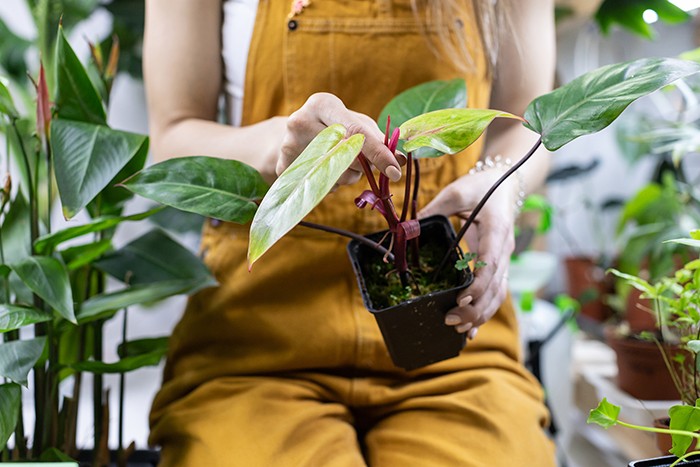Maybe it started with the pandemic, when we were all sequestered in our homes and desperate to bring the outside in. Or maybe the Millennials and Gen Z are to blame, with their houseplant Instagram accounts and plant-crazy hashtags, like #plantsofinstagram and #urbanjungle. Either way, houseplant hysteria has taken over, and people just can’t seem to get enough cozy spaces full of potted plants.
“I believe the trend was already underway, but COVID amplified it exponentially,” said Shannon Theis, the tropical buyer at Garden Supply Company in Cary. “With everyone hunkering down and staying home, we longed for healthy, sustainable hobbies.”
Becoming a proud plant parent might be easier than raising humans, in the sense that they don’t require a college fund and they don’t talk back. But make no mistake — maintaining and caring for houseplants isn’t always a walk in the park. Whether it’s succulents, snake plants or eucalyptus hanging in your shower (yes, that’s a thing), we’ve got some important insight and helpful tips for raising Morgan Treeman or Cactus Everdeen.
Health Benefits of Houseplants
While it’s true that houseplants and indoor greenery have taken the design world by storm, they have potential beyond adding visual interest and livening up the space. Many houseplants have been scientifically proven to reduce stress, improve air quality and boost mental health, along with other benefits.
In the 1980s, the National Aeronautic and Space Administration (NASA) tested the abilities of three common houseplants to remove formaldehyde from the air, and the spider plant came out on top — removing 95% of formaldehyde from a sealed Plexiglas chamber within 24 hours. Since then, many other formaldehyde-reducing houseplants have been identified, including the peace lily, money plant, rubber tree and snake plant, to name a few.
- African Violets
- Parlor Palms
- Areca Palms
- Friendship Plants
- Spider Plants
- Waffle Plants
- Calathea
According to a report by the US Consumer Product Safety Commission, formaldehyde — a colorless gas used in building materials and household products that’s classified as a probable human carcinogen under prolonged exposure — is normally present at low levels in both indoor and outdoor air. So the existence of Christofern, your happy houseplant, might lower your risk of cancer while you’re working from home.
In addition to formaldehyde, harmful indoor pollutants include trichloroethylene (found in paints and varnishes), benzene (found in tobacco smoke and dyes), xylene (released in car exhausts) and ammonia (found in window cleaners and floor wax). Through the process of photosynthesis, houseplants purify the air by converting the carbon dioxide we exhale into fresh oxygen and removing toxins from the air. Peace lilies and chrysanthemums have been proven to reduce the levels of all five air pollutants listed above.
But wait, there’s more! Houseplants can also reduce stress and boost mental health. Mycobacterium vaccae, a bacterium in plant soil, actually triggers the release of serotonin. Additionally, just smelling, pruning, touching and seeing houseplants can reduce stress and improve overall mood.
Trending Houseplants
As a tropical buyer, longtime houseplant lover and lifetime gardener, Theis has her finger on the pulse of what’s trending in the plant world.
“We are seeing a huge uptick in aroids in general, specifically elephant ears (Alocasia), Monsteras, Philodendrons, and Anthuriums. Anything variegated (exhibiting different colors) is highly popular, especially in the Monstera family,” said Theis.
“Bonsai gardens are amping up in popularity again, and we are fortunate enough to be working directly with the Triangle Bonsai Society to bring bonsai workshops right to our store.”
An emerging trend similar to bonsai, according to Theis, is a plant called Kokedama. The centuries-old Japanese form of garden art also goes by the easier-to-pronounce name “Japanese moss ball.”
“At Garden Supply we are incredibly proud and excited to be carrying this hand-woven art form from an amazing family in Florida who owns Kazumi Gardens,” said Theis.
- The Money Tree
- Snake Plant
- Spider Plant
- Golden Pothos
- Peace Lily
- Rubber Plant
- Pothos
- Philodendron
- Peperomia
- Alocasia
- ZZ Plant
Eucalyptus has also made an appearance in the shower as of late. Known for its medicinal properties, eucalyptus relieves congestion, sinus headaches and reduces inflammation. Along with the steam from the hot running water, the oils in the eucalyptus will have you feeling better and finding your Zen in no time. Plus, a little greenery can transform your small bathroom into a spa! Who wouldn’t want that?
Low-Maintenance Houseplants
If your green thumb has a history of turning black, there are plenty of options for clueless pandemic plant parents. The most amazing low-maintenance houseplants are snake plants (Sansevieria), with options ranging from upright and tall to squat and full. Snake plants tolerate low-light conditions and rarely need watering, but they do thrive and drink more frequently in brighter conditions.
“Other low-maintenance options for low light and low maintenance would be Pothos (Epipremnum), Dracaena or Chinese Evergreen (Aglaonema),” suggested Theis. “While these do flower, the true show in Aglaonema is the wide variety of color in the foliage and stems.”
Make It Sustainable
A fancy houseplant wish list can often lead to imported plants, and thus a larger carbon footprint, but there are some simple solutions to make house-planting more eco-friendly.
Propagating houseplants, whether by dividing or stem/leaf cutting, is a great way to expand your plant collection for free.
“Some plants propagate in water, while others need to callus before being placed in soil. There are several compostable pots within which plants can be grown, such as coco coir, peat moss, or cowpots,” said Theis.
“Unfortunately, most of our plants come to us in plastic grower pots. While these can be recycled in a variety of ways, such as pot filler in a very tall pot or transplanting younger plants, I do think our industry needs to do a better job of moving toward sustainable, compostable mediums. Here at Garden Supply, we recycle all of our pots in the form of reusing them at our farm or giving them to our customers for replanting.”
Plant swaps are also a great way to sustain houseplants. The Cary Garden Club meets the first Tuesday of each month and hosts a luncheon and plant swap every year.
- Pothos
- ZZ Plant
- String of Hearts
- Chinese Money Plant
- Snake Plant
“All of our members bring plants that they’ve grown at home,” said Marie Martin, president of the Cary Garden Club. “If you bring a plant, then you go home with a plant. You get a number, and when your number comes up, you go and pick up a plant that you want and take it home with you. It’s very beneficial for everyone.”
Parting Advice for “Pot Heads,” Courtesy of Garden Supply Company
“I always recommend that people buy plants from a local garden center,” said owner Keith Ramsey. “You get great advice on low-light plants and plants that can handle the dry climate of an indoor environment. When you go to a lumberyard, most of the plants are planted in really light soil shipped from long distances and tend to fail quicker.”
“Also, try to pick a day and water on the same day. Use your finger as a water soil probe. If you can feel moisture an inch down, the plant needs very little water. If it’s very dry to the touch, water thoroughly and don’t water for another week.”
“One last thing is people should have fun with interior gardening. Don’t take it too personally if a plant fails,” said Theis. “Like anything else in life, there is a learning curve to care for plants. I encourage one to focus on what they learned from the experience and not become discouraged.”
- 2022 Maggy Awards: Shopping
- 2022 Maggy Awards: Services
- 2022 Maggy Awards: Lifestyle
- 2022 Maggy Awards: Restaurants
- Presenting the 2022 Maggy Awards: Best of Cary Magazine
- Local Soil Mates
- Things to Do: April 2022
- Restaurant Profile: Big Mike’s BBQ
- Worth the Drive: Zeera Indian Restaurant
- Houseplants: Your New Best Fronds
- Small Business Spotlight: The Wine Merchant
- Nonprofit Spotlight: Friends of Hemlock Bluffs
- Liquid Assets: Why is Sally So Dangerous?
- Liquid Assets: Cary Gold from Bond Brothers Beer Company
- On Trend: Copperline Plant Co.
- Garden Adventurer: The Little Tomatoes






